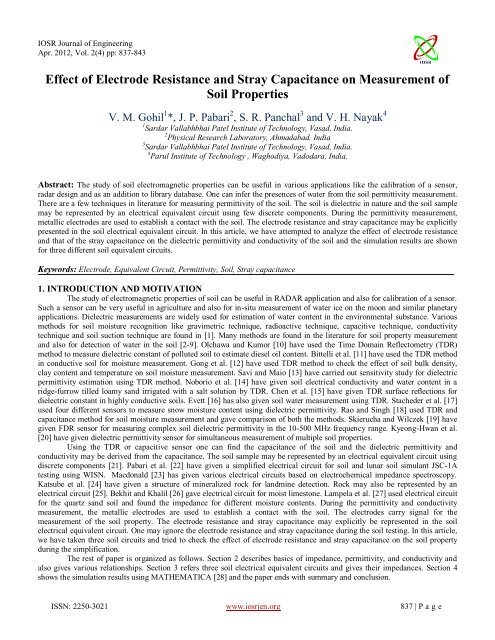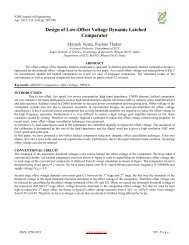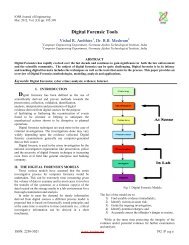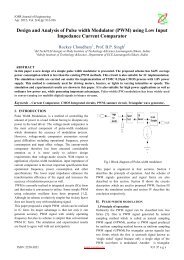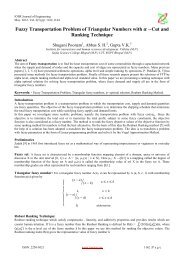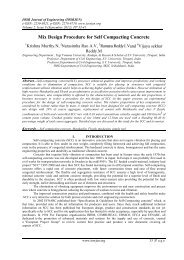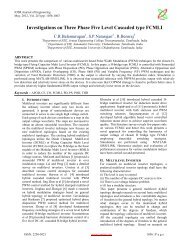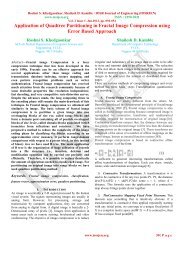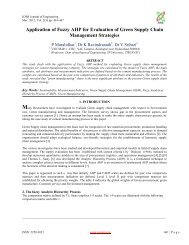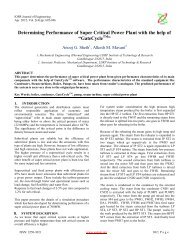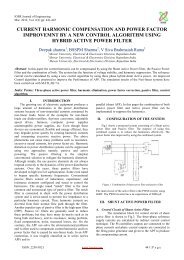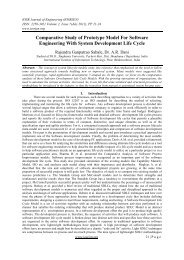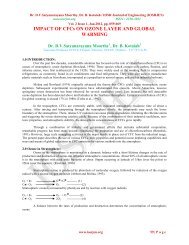Effect of Electrode Resistance and Stray Capacitance on ... - IOSRJEN
Effect of Electrode Resistance and Stray Capacitance on ... - IOSRJEN
Effect of Electrode Resistance and Stray Capacitance on ... - IOSRJEN
You also want an ePaper? Increase the reach of your titles
YUMPU automatically turns print PDFs into web optimized ePapers that Google loves.
IOSR Journal <str<strong>on</strong>g>of</str<strong>on</strong>g> Engineering<br />
Apr. 2012, Vol. 2(4) pp: 837-843<br />
<str<strong>on</strong>g>Effect</str<strong>on</strong>g> <str<strong>on</strong>g>of</str<strong>on</strong>g> <str<strong>on</strong>g>Electrode</str<strong>on</strong>g> <str<strong>on</strong>g>Resistance</str<strong>on</strong>g> <str<strong>on</strong>g>and</str<strong>on</strong>g> <str<strong>on</strong>g>Stray</str<strong>on</strong>g> <str<strong>on</strong>g>Capacitance</str<strong>on</strong>g> <strong>on</strong> Measurement <str<strong>on</strong>g>of</str<strong>on</strong>g><br />
Soil Properties<br />
V. M. Gohil 1 *, J. P. Pabari 2 , S. R. Panchal 3 <str<strong>on</strong>g>and</str<strong>on</strong>g> V. H. Nayak 4<br />
1 Sardar Vallabhbhai Patel Institute <str<strong>on</strong>g>of</str<strong>on</strong>g> Technology, Vasad, India.<br />
2 Physical Research Laboratory, Ahmadabad, India<br />
3 Sardar Vallabhbhai Patel Institute <str<strong>on</strong>g>of</str<strong>on</strong>g> Technology, Vasad, India.<br />
4 Parul Institute <str<strong>on</strong>g>of</str<strong>on</strong>g> Technology , Waghodiya, Vadodara, India.<br />
Abstract: The study <str<strong>on</strong>g>of</str<strong>on</strong>g> soil electromagnetic properties can be useful in various applicati<strong>on</strong>s like the calibrati<strong>on</strong> <str<strong>on</strong>g>of</str<strong>on</strong>g> a sensor,<br />
radar design <str<strong>on</strong>g>and</str<strong>on</strong>g> as an additi<strong>on</strong> to library database. One can infer the presences <str<strong>on</strong>g>of</str<strong>on</strong>g> water from the soil permittivity measurement.<br />
There are a few techniques in literature for measuring permittivity <str<strong>on</strong>g>of</str<strong>on</strong>g> the soil. The soil is dielectric in nature <str<strong>on</strong>g>and</str<strong>on</strong>g> the soil sample<br />
may be represented by an electrical equivalent circuit using few discrete comp<strong>on</strong>ents. During the permittivity measurement,<br />
metallic electrodes are used to establish a c<strong>on</strong>tact with the soil. The electrode resistance <str<strong>on</strong>g>and</str<strong>on</strong>g> stray capacitance may be explicitly<br />
presented in the soil electrical equivalent circuit. In this article, we have attempted to analyze the effect <str<strong>on</strong>g>of</str<strong>on</strong>g> electrode resistance<br />
<str<strong>on</strong>g>and</str<strong>on</strong>g> that <str<strong>on</strong>g>of</str<strong>on</strong>g> the stray capacitance <strong>on</strong> the dielectric permittivity <str<strong>on</strong>g>and</str<strong>on</strong>g> c<strong>on</strong>ductivity <str<strong>on</strong>g>of</str<strong>on</strong>g> the soil <str<strong>on</strong>g>and</str<strong>on</strong>g> the simulati<strong>on</strong> results are shown<br />
for three different soil equivalent circuits.<br />
Keywords: <str<strong>on</strong>g>Electrode</str<strong>on</strong>g>, Equivalent Circuit, Permittivity, Soil, <str<strong>on</strong>g>Stray</str<strong>on</strong>g> capacitance<br />
1. INTRODUCTION AND MOTIVATION<br />
The study <str<strong>on</strong>g>of</str<strong>on</strong>g> electromagnetic properties <str<strong>on</strong>g>of</str<strong>on</strong>g> soil can be useful in RADAR applicati<strong>on</strong> <str<strong>on</strong>g>and</str<strong>on</strong>g> also for calibrati<strong>on</strong> <str<strong>on</strong>g>of</str<strong>on</strong>g> a sensor.<br />
Such a sensor can be very useful in agriculture <str<strong>on</strong>g>and</str<strong>on</strong>g> also for in-situ measurement <str<strong>on</strong>g>of</str<strong>on</strong>g> water ice <strong>on</strong> the mo<strong>on</strong> <str<strong>on</strong>g>and</str<strong>on</strong>g> similar planetary<br />
applicati<strong>on</strong>s. Dielectric measurements are widely used for estimati<strong>on</strong> <str<strong>on</strong>g>of</str<strong>on</strong>g> water c<strong>on</strong>tent in the envir<strong>on</strong>mental substance. Various<br />
methods for soil moisture recogniti<strong>on</strong> like gravimetric technique, radioactive technique, capacitive technique, c<strong>on</strong>ductivity<br />
technique <str<strong>on</strong>g>and</str<strong>on</strong>g> soil sucti<strong>on</strong> technique are found in [1]. Many methods are found in the literature for soil property measurement<br />
<str<strong>on</strong>g>and</str<strong>on</strong>g> also for detecti<strong>on</strong> <str<strong>on</strong>g>of</str<strong>on</strong>g> water in the soil [2-9]. Olchawa <str<strong>on</strong>g>and</str<strong>on</strong>g> Kumor [10] have used the Time Domain Reflectometry (TDR)<br />
method to measure dielectric c<strong>on</strong>stant <str<strong>on</strong>g>of</str<strong>on</strong>g> polluted soil to estimate diesel oil c<strong>on</strong>tent. Bittelli et al. [11] have used the TDR method<br />
in c<strong>on</strong>ductive soil for moisture measurement. G<strong>on</strong>g et al. [12] have used TDR method to check the effect <str<strong>on</strong>g>of</str<strong>on</strong>g> soil bulk density,<br />
clay c<strong>on</strong>tent <str<strong>on</strong>g>and</str<strong>on</strong>g> temperature <strong>on</strong> soil moisture measurement. Savi <str<strong>on</strong>g>and</str<strong>on</strong>g> Maio [13] have carried out sensitivity study for dielectric<br />
permittivity estimati<strong>on</strong> using TDR method. Noborio et al. [14] have given soil electrical c<strong>on</strong>ductivity <str<strong>on</strong>g>and</str<strong>on</strong>g> water c<strong>on</strong>tent in a<br />
ridge-furrow tilled loamy s<str<strong>on</strong>g>and</str<strong>on</strong>g> irrigated with a salt soluti<strong>on</strong> by TDR. Chen et al. [15] have given TDR surface reflecti<strong>on</strong>s for<br />
dielectric c<strong>on</strong>stant in highly c<strong>on</strong>ductive soils. Evett [16] has also given soil water measurement using TDR. Stacheder et al. [17]<br />
used four different sensors to measure snow moisture c<strong>on</strong>tent using dielectric permittivity. Rao <str<strong>on</strong>g>and</str<strong>on</strong>g> Singh [18] used TDR <str<strong>on</strong>g>and</str<strong>on</strong>g><br />
capacitance method for soil moisture measurement <str<strong>on</strong>g>and</str<strong>on</strong>g> gave comparis<strong>on</strong> <str<strong>on</strong>g>of</str<strong>on</strong>g> both the methods. Skierucha <str<strong>on</strong>g>and</str<strong>on</strong>g> Wilczek [19] have<br />
given FDR sensor for measuring complex soil dielectric permittivity in the 10-500 MHz frequency range. Kye<strong>on</strong>g-Hwan et al.<br />
[20] have given dielectric permittivity sensor for simultaneous measurement <str<strong>on</strong>g>of</str<strong>on</strong>g> multiple soil properties.<br />
Using the TDR or capacitive sensor <strong>on</strong>e can find the capacitance <str<strong>on</strong>g>of</str<strong>on</strong>g> the soil <str<strong>on</strong>g>and</str<strong>on</strong>g> the dielectric permittivity <str<strong>on</strong>g>and</str<strong>on</strong>g><br />
c<strong>on</strong>ductivity may be derived from the capacitance. The soil sample may be represented by an electrical equivalent circuit using<br />
discrete comp<strong>on</strong>ents [21]. Pabari et al. [22] have given a simplified electrical circuit for soil <str<strong>on</strong>g>and</str<strong>on</strong>g> lunar soil simulant JSC-1A<br />
testing using WISN. Macd<strong>on</strong>ald [23] has given various electrical circuits based <strong>on</strong> electrochemical impedance spectroscopy.<br />
Katsube et al. [24] have given a structure <str<strong>on</strong>g>of</str<strong>on</strong>g> mineralized rock for l<str<strong>on</strong>g>and</str<strong>on</strong>g>mine detecti<strong>on</strong>. Rock may also be represented by an<br />
electrical circuit [25]. Bekhit <str<strong>on</strong>g>and</str<strong>on</strong>g> Khalil [26] gave electrical circuit for moist limest<strong>on</strong>e. Lampela et al. [27] used electrical circuit<br />
for the quartz s<str<strong>on</strong>g>and</str<strong>on</strong>g> soil <str<strong>on</strong>g>and</str<strong>on</strong>g> found the impedance for different moisture c<strong>on</strong>tents. During the permittivity <str<strong>on</strong>g>and</str<strong>on</strong>g> c<strong>on</strong>ductivity<br />
measurement, the metallic electrodes are used to establish a c<strong>on</strong>tact with the soil. The electrodes carry signal for the<br />
measurement <str<strong>on</strong>g>of</str<strong>on</strong>g> the soil property. The electrode resistance <str<strong>on</strong>g>and</str<strong>on</strong>g> stray capacitance may explicitly be represented in the soil<br />
electrical equivalent circuit. One may ignore the electrode resistance <str<strong>on</strong>g>and</str<strong>on</strong>g> stray capacitance during the soil testing. In this article,<br />
we have taken three soil circuits <str<strong>on</strong>g>and</str<strong>on</strong>g> tried to check the effect <str<strong>on</strong>g>of</str<strong>on</strong>g> electrode resistance <str<strong>on</strong>g>and</str<strong>on</strong>g> stray capacitance <strong>on</strong> the soil property<br />
during the simplificati<strong>on</strong>.<br />
The rest <str<strong>on</strong>g>of</str<strong>on</strong>g> paper is organized as follows. Secti<strong>on</strong> 2 describes basics <str<strong>on</strong>g>of</str<strong>on</strong>g> impedance, permittivity, <str<strong>on</strong>g>and</str<strong>on</strong>g> c<strong>on</strong>ductivity <str<strong>on</strong>g>and</str<strong>on</strong>g><br />
also gives various relati<strong>on</strong>ships. Secti<strong>on</strong> 3 refers three soil electrical equivalent circuits <str<strong>on</strong>g>and</str<strong>on</strong>g> gives their impedances. Secti<strong>on</strong> 4<br />
shows the simulati<strong>on</strong> results using MATHEMATICA [28] <str<strong>on</strong>g>and</str<strong>on</strong>g> the paper ends with summary <str<strong>on</strong>g>and</str<strong>on</strong>g> c<strong>on</strong>clusi<strong>on</strong>.<br />
ISSN: 2250-3021 www.iosrjen.org 837 | P a g e
IOSR Journal <str<strong>on</strong>g>of</str<strong>on</strong>g> Engineering<br />
Apr. 2012, Vol. 2(4) pp: 837-843<br />
´<br />
f (MHz)<br />
Figure 4: (a) Plot <str<strong>on</strong>g>of</str<strong>on</strong>g> real relative permittivity vs. frequency <str<strong>on</strong>g>and</str<strong>on</strong>g> (b) plot <str<strong>on</strong>g>of</str<strong>on</strong>g> c<strong>on</strong>ductivity vs. frequency for circuit 1<br />
´<br />
7.0<br />
6.0<br />
5.0<br />
4.0<br />
3.0<br />
2.0<br />
1.0<br />
0.0<br />
Circuit 1<br />
0 2 4 6 8 10<br />
f (MHz)<br />
Circuit 2<br />
Figure 5: (a) Plot <str<strong>on</strong>g>of</str<strong>on</strong>g> real relative permittivity vs. electrode resistance <str<strong>on</strong>g>and</str<strong>on</strong>g> (b) plot <str<strong>on</strong>g>of</str<strong>on</strong>g> c<strong>on</strong>ductivity vs. electrode resistance for<br />
circuit 2<br />
Figure 6: (a) Plot <str<strong>on</strong>g>of</str<strong>on</strong>g> real relative permittivity vs. stray capacitance <str<strong>on</strong>g>and</str<strong>on</strong>g> (b) plot <str<strong>on</strong>g>of</str<strong>on</strong>g> c<strong>on</strong>ductivity vs. stray capacitance for circuit 3<br />
5. DISCUSSION<br />
5.1 <str<strong>on</strong>g>Effect</str<strong>on</strong>g> <str<strong>on</strong>g>of</str<strong>on</strong>g> <str<strong>on</strong>g>Electrode</str<strong>on</strong>g> <str<strong>on</strong>g>Resistance</str<strong>on</strong>g> <strong>on</strong> Permittivity <str<strong>on</strong>g>and</str<strong>on</strong>g> C<strong>on</strong>ductivity:<br />
By comparing the first (circuit 1) <str<strong>on</strong>g>and</str<strong>on</strong>g> the sec<strong>on</strong>d (circuit 2) circuits, <strong>on</strong>e can observe that when the electrode resistance is varied<br />
from 1 to 3 , there is no appreciable change in case <str<strong>on</strong>g>of</str<strong>on</strong>g> soil permittivity. Hence, <strong>on</strong>e can ignore the electrode resistance during<br />
the permittivity measurement. However, as the value <str<strong>on</strong>g>of</str<strong>on</strong>g> the electrode resistance is changed, the value <str<strong>on</strong>g>of</str<strong>on</strong>g> the soil c<strong>on</strong>ductivity also<br />
changes by a very small amount in the frequency range from 1 MHz to 10 MHz.<br />
5.2 <str<strong>on</strong>g>Effect</str<strong>on</strong>g> <str<strong>on</strong>g>of</str<strong>on</strong>g> <str<strong>on</strong>g>Stray</str<strong>on</strong>g> <str<strong>on</strong>g>Capacitance</str<strong>on</strong>g> <strong>on</strong> Permittivity <str<strong>on</strong>g>and</str<strong>on</strong>g> C<strong>on</strong>ductivity<br />
By comparing circuit 3 <str<strong>on</strong>g>and</str<strong>on</strong>g> circuit 1, <strong>on</strong>e can observe that when the stray capacitance is varied from 0.1 pF to 1 pF, there is no<br />
appreciable change in case <str<strong>on</strong>g>of</str<strong>on</strong>g> soil c<strong>on</strong>ductivity. Hence, <strong>on</strong>e may ignore the stray capacitance during the c<strong>on</strong>ductivity<br />
measurement. However, as the value <str<strong>on</strong>g>of</str<strong>on</strong>g> the stray capacitance is changed from 0.1 pF to 1 pF, the value <str<strong>on</strong>g>of</str<strong>on</strong>g> the soil permittivity<br />
ISSN: 2250-3021 www.iosrjen.org 841 | P a g e<br />
80<br />
70<br />
60<br />
50<br />
40<br />
30<br />
20<br />
10<br />
Circuit 1<br />
0 2 4 6 8 10<br />
Circuit 2<br />
Circuit 3 Circuit 3
IOSR Journal <str<strong>on</strong>g>of</str<strong>on</strong>g> Engineering<br />
Apr. 2012, Vol. 2(4) pp: 837-843<br />
SUMMARY AND CONCLUSION<br />
In this paper, we have derived the impedances <str<strong>on</strong>g>of</str<strong>on</strong>g> the three soil electrical equivalent circuits which may be used in obtaining the<br />
soil properties. The three circuits have been compared <str<strong>on</strong>g>and</str<strong>on</strong>g> the effects <str<strong>on</strong>g>of</str<strong>on</strong>g> the electrode resistance <str<strong>on</strong>g>and</str<strong>on</strong>g> the stray capacitance are<br />
checked <strong>on</strong> the measurements <str<strong>on</strong>g>of</str<strong>on</strong>g> the soil permittivity <str<strong>on</strong>g>and</str<strong>on</strong>g> the c<strong>on</strong>ductivity. The error in soil c<strong>on</strong>ductivity is n<strong>on</strong>linear with<br />
respect to the electrode resistance <str<strong>on</strong>g>and</str<strong>on</strong>g> there is no effect <str<strong>on</strong>g>of</str<strong>on</strong>g> electrode resistance <strong>on</strong> the soil permittivity. For every multiple <str<strong>on</strong>g>of</str<strong>on</strong>g> 0.1<br />
pF stray capacitance, the error in the soil permittivity is increased by 3.33 %, while there is no effect <strong>on</strong> the soil c<strong>on</strong>ductivity.<br />
REFERENCES<br />
[1] Skye instrument limited, “Soil Moisture Measurement Notes”. Online, 20 th March 22, 2012. Available:<br />
http://www.skyeinstruments.com.<br />
[2] Online, 20 th March 22, 2012. Available:<br />
http://asadl.org/jasa/resource/1/jasman/v77/i4/p1601_s1?isAuthorized=no.<br />
[3] Online, 20 th March 22, 2012. Available: http://www.lightningman.com.au/Earthing.pdf.<br />
[4] Online, 20 th March 22, 2012. Available: http://en.wikipedia.org/wiki/Capacitive_sensing.<br />
[5] Online, 20 th March 22, 2012. Available: http://cp.literature.agilent.com/litweb/pdf/5989-4149EN.pdf.<br />
[6] Online, 20 th March 22, 2012. Available:<br />
http://www.artisan-scientific.com/info/tektr<strong>on</strong>ix_measuringc<strong>on</strong>trolledimpedanceboardswithtdrarticle.pdf<br />
[7] Online, 20 th March 22, 2012. Available: http://cp.literature.agilent.com/litweb/pdf/5950-3000.pdf.<br />
[8] Online, 20 th March 22, 2012. Available:<br />
http://www.experimental-hydrology.net/wiki/index.php?title=Soil_moisture_-_impedance_method_(Theta_Probe)<br />
[9] Online, 5 th January, 2012. Available:<br />
http://seismo.berkeley.edu/~rallen/teaching/F04_GEO594_IntroAppGeophys/Lectures/L8.pdf.<br />
[10] Andrzej Olchawa <str<strong>on</strong>g>and</str<strong>on</strong>g> Maciej Kumor, “Time Domain Reflectometry (TDR) – Measuring Dielectric C<strong>on</strong>stant <str<strong>on</strong>g>of</str<strong>on</strong>g> Polluted<br />
Soil to Estimate Diesel Oil C<strong>on</strong>tent”, Archives <str<strong>on</strong>g>of</str<strong>on</strong>g> Hydro-Engineering <str<strong>on</strong>g>and</str<strong>on</strong>g> Envir<strong>on</strong>mental Mechanics, Vol. 55, No. 1-2,<br />
2008, pp. 55-62.<br />
[11] Marco Bittelli, Fiorenzo Salvatorelli <str<strong>on</strong>g>and</str<strong>on</strong>g> Paola Rossi Pisa, “Correcti<strong>on</strong> <str<strong>on</strong>g>of</str<strong>on</strong>g> TDR-based soil water c<strong>on</strong>tent measurements in<br />
c<strong>on</strong>ductive soils”, Geoderma, Elsevier, Vol. 143, 2008, pp. 133-142.<br />
[12] Yuanshi G<strong>on</strong>g, Qiaoh<strong>on</strong>g Cao <str<strong>on</strong>g>and</str<strong>on</strong>g> Z<strong>on</strong>gjia Sun, “The effects <str<strong>on</strong>g>of</str<strong>on</strong>g> soil bulk density, clay c<strong>on</strong>tent <str<strong>on</strong>g>and</str<strong>on</strong>g> temperature <strong>on</strong> soil<br />
water c<strong>on</strong>tent measurement using time-domain reflectometry”, Hydrological Processes, Wiley InterScience, Vol. 17, 2003,<br />
pp. 3601-3614.<br />
[13] P. Savi <str<strong>on</strong>g>and</str<strong>on</strong>g> I.A. Maio, “Sensitivity Study for Dielectric Permittivity Estimati<strong>on</strong> via TDR Measurements”, Online, 16 th April<br />
2012. Available: http://www.emc.polito.it/publicati<strong>on</strong>s/file/cnf-2006-medmicrowave-sensitivity.pdf.<br />
[14] K. Noborio, K. J. McInnes <str<strong>on</strong>g>and</str<strong>on</strong>g> J. L. Heilman, “Field measurements <str<strong>on</strong>g>of</str<strong>on</strong>g> soil electrical c<strong>on</strong>ductivity <str<strong>on</strong>g>and</str<strong>on</strong>g> water c<strong>on</strong>tent by timedomain<br />
reflectometry”, Computers <str<strong>on</strong>g>and</str<strong>on</strong>g> Electr<strong>on</strong>ics in Agriculture, Elsvier, Vol. 11, Issues 2-3, 1994, pp. 131-142.<br />
[15] Renpeng Chen, Vincent P. Drnevich, Xi<strong>on</strong>g Yu, Robert L. Nowack <str<strong>on</strong>g>and</str<strong>on</strong>g> Yunmin Chen, “Time Domain Reflectometry<br />
Surface Reflecti<strong>on</strong>s for Dielectric C<strong>on</strong>stant in Highly C<strong>on</strong>ductive Soils”, J. Geotech. Geoenvir<strong>on</strong>. Eng., Vol. 133, 2007, p.<br />
1597.<br />
[16] Steven R. Evett, “Soil Water Measurement by Time Domain Reflectometry”, Encyclopedia <str<strong>on</strong>g>of</str<strong>on</strong>g> Water Science, Marcel<br />
Dekker Inc. New York, 2003, pp. 894-898.<br />
[17] Markus Stacheder, Franz Koeniger <str<strong>on</strong>g>and</str<strong>on</strong>g> Rainer Schuhmann, “New Dielectric Sensors <str<strong>on</strong>g>and</str<strong>on</strong>g> Sensing Techniques for Soil <str<strong>on</strong>g>and</str<strong>on</strong>g><br />
Snow Moisture Measurements”, Sensors, 2009, Vol. 9, pp. 2951-2967.<br />
[18] B. Hanumantha Rao <str<strong>on</strong>g>and</str<strong>on</strong>g> D. N. Singh, “Moisture C<strong>on</strong>tent Determinati<strong>on</strong> by TDR <str<strong>on</strong>g>and</str<strong>on</strong>g> <str<strong>on</strong>g>Capacitance</str<strong>on</strong>g> Techniques: A<br />
Comparative Study”, Internati<strong>on</strong>al Journal <str<strong>on</strong>g>of</str<strong>on</strong>g> Earth Sciences <str<strong>on</strong>g>and</str<strong>on</strong>g> Engineering, Vol. 4, No. 6 SPL, 2011, pp. 132-137.<br />
[19] Wojciech Skierucha <str<strong>on</strong>g>and</str<strong>on</strong>g> Andrzej Wilczek, “A FDR Sensor for Measuring Complex Soil Dielectric Permittivity in the 10-<br />
500 MHz Frequency Range”, Sensors, Vol. 10, 2010, pp. 3314-3329.<br />
[20] Kye<strong>on</strong>g-Hwan, Lee Naiqian Zhang, Gerard Kluitenberg, William B. Kuhn <str<strong>on</strong>g>and</str<strong>on</strong>g> Sanjoy Das, “Dielectric Permittivity Sensor<br />
for Simultaneous Measurement <str<strong>on</strong>g>of</str<strong>on</strong>g> Multiple Soil Properties”, ASAE Annual Meeting, American Society <str<strong>on</strong>g>of</str<strong>on</strong>g> Agricultural <str<strong>on</strong>g>and</str<strong>on</strong>g><br />
Biological Engineers, Paper No. 041045, 2004.<br />
[21] Online, 20 th March, 2012. Available:<br />
http://seismo.berkeley.edu/~rallen/teaching/F04_GEO594_IntroAppGeophys/Lectures/L8.pdf.<br />
[22] J. P. Pabari, Y. B. Acharya, U. B. Desai <str<strong>on</strong>g>and</str<strong>on</strong>g> S. N. Merchant, “Development <str<strong>on</strong>g>of</str<strong>on</strong>g> Impedance Based, Miniaturized Wireless<br />
Water Ice Sensor for Future Planetary Applicati<strong>on</strong>s”, IEEE Transacti<strong>on</strong>s <strong>on</strong> Instrumentati<strong>on</strong> <str<strong>on</strong>g>and</str<strong>on</strong>g> Measurement, Vol. 61,<br />
Issue 2, 2012, pp. 521-529.<br />
[23] J. Ross Macd<strong>on</strong>ald, “Impedance Spectroscopy”, Annals <str<strong>on</strong>g>of</str<strong>on</strong>g> Biomedical Engineering, Vol. 20, 1992, pp. 289-305.<br />
[24] T. J. Katsube, E. Grunsky, Y. Das, R. DiLabio, H. McVairn, S. C<strong>on</strong>nell-Madora, E.Gauthier <str<strong>on</strong>g>and</str<strong>on</strong>g> N. Scromeda, “Physical<br />
model <str<strong>on</strong>g>of</str<strong>on</strong>g> soil <str<strong>on</strong>g>and</str<strong>on</strong>g> its implicati<strong>on</strong>s for l<str<strong>on</strong>g>and</str<strong>on</strong>g>mine detecti<strong>on</strong> interferences”, Proc. <str<strong>on</strong>g>of</str<strong>on</strong>g> SPIE, Vol. 6217, 62170N, 2006.<br />
ISSN: 2250-3021 www.iosrjen.org 843 | P a g e
IOSR Journal <str<strong>on</strong>g>of</str<strong>on</strong>g> Engineering<br />
Apr. 2012, Vol. 2(4) pp: 837-843<br />
[25] Online, 27 th March, 2012. Available: http://appliedgeophysics.lbl.gov/dc/em43.pdf.<br />
[26] Marzouk M. Bekhit <str<strong>on</strong>g>and</str<strong>on</strong>g> Saad A. Khalil, “Electrical Properties <str<strong>on</strong>g>of</str<strong>on</strong>g> Moist Limest<strong>on</strong>e Samples In The Frequency Range 1Hz-<br />
10 Hz From Abu Rawash Area”, Australian Journal <str<strong>on</strong>g>of</str<strong>on</strong>g> Basic <str<strong>on</strong>g>and</str<strong>on</strong>g> Applied Sciences, Vol. 1, No. 4, 2007, pp. 741-750.<br />
[27] Mika Lampela, Tapani Repo, Raimo Silvennoinen <str<strong>on</strong>g>and</str<strong>on</strong>g> Leena Finer, “Equivalent electrical circuit model for system<br />
c<strong>on</strong>taining quartz s<str<strong>on</strong>g>and</str<strong>on</strong>g> <str<strong>on</strong>g>and</str<strong>on</strong>g> purified water”, Online, 16 th April, 2012. Available:<br />
http://www.metla.fi/jo/juuristolaboratorio/pdf/Poster6_Lampela%20et%20al_Poster%20in%20E38%20Rovaniemi.pdf.<br />
[28] Online, 5 th January, 2012. Available: www.wolfram.com/mathematica/.<br />
[29] Online, 5 th January, 2012. Available : http://en.wikipedia.org/wiki/Electrical_impedance.<br />
[30] Online, 5 th January, 2012. Available : http://en.wikipedia.org/wiki/Dielectric_c<strong>on</strong>stant.<br />
ISSN: 2250-3021 www.iosrjen.org 844 | P a g e


